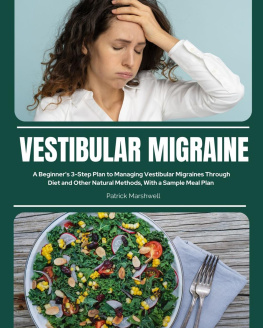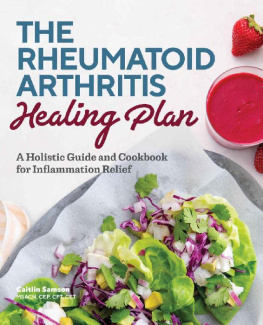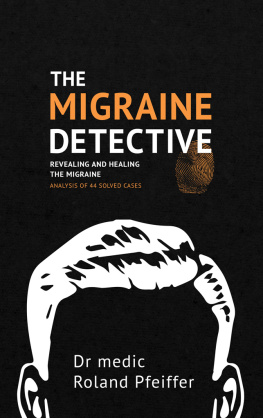Contents
Guide
Pagebreaks of the Print Version

MigraineRelief Plan COOKBOOK
More Than 100 Anti-InflammatoryRecipes for Managing Headaches andLiving a Healthier Life
Stephanie Weaver, MPH

AN AGATE IMPRINT
CHICAGO
This book is intended to supplement, not replace, the advice of a trained health professional. If you know or suspect that you have a health problem, you should consult with a health professional. The author and publisher specifically disclaim any liability, loss, or risk, personal or otherwise, that is incurred as a consequence, directly or indirectly, of the use and application of any of the contents of this book.
The field of migraine medicine and research is always changing. This book reflects the state of knowledge when it went to publication.
Copyright 2022 by Stephanie Weaver
All rights reserved. No part of this book may be reproduced or transmitted in any form or by any means, electronic or mechanical, including photocopying, recording, or by any information storage and retrieval system, without express written permission from the publisher.
First printed in July 2022
Printed in China
10 9 8 7 6 5 4 3 2 1 22 23 24 25 26
Cataloging-in-Publication Data is available from the Library of Congress.
ISBN 13: 978-1-57284-311-0
ISBN 10: 1-57284-311-X
eISBN 13: 978-1-57284-859-7
eISBN 10: 1-57284-859-6
Surrey Books is an imprint of Agate Publishing. Agate books are available in bulk at discount prices. For more information, visit agatepublishing.com.
For everyone living with chronic illness, including my friends in the migraine community.

Contents

Foreword
RESILIENCE IS DEFINED AS an ability to recover from or adjust to challenges or change. Or, as meditation researcher Jon Kabat-Zinn put it, You cant stop the waves, but you can learn to surf. Living with any chronic disease is a series of adjusting to challenges. Resilience is how we surf. Living with migraine disease can be challenging. Its important to care for both body and mind by enhancing physical and psychological health and resilience. While there is currently no cure for migraine, there are a wide range of actions and treatments that play a major role in managing migraine attacks, enhancing resilience, and allowing you to live the life that you want to live. The goals of migraine management are to prevent attacks when possible, and to shorten the intensity, duration, and disability of those that do occur, using non-medication and medication approaches. Eating well is one of the foundational lifestyle aspects that can enhance physical and psychological resilience.
Migraine is a common disease that is estimated to affect more than 1 billion people around the world and an estimated 40 million Americans.).
Someone with migraine has a sensitive nervous system that responds to changes in the internal and external environment. These risk factors are often called triggers. A migraine attack can happen when the combination of biological and environmental risk factors exceeds an individuals biological threshold. Some people can sense when a migraine attack is about to happen and feel that certain situations and/or events might make an attack more likely. Other people feel that attacks happen out of the blue. Risk factors can stack up to raise the risk of an attack, and if they pass over a biological migraine attack threshold, an attack may occur. Everyone has a migraine attack threshold, which can rise or lower depending on a variety of external and internal variables. Some ways to raise this threshold to reduce the chance of migraine attacks and stack the odds in your favor include healthy nutrition, regular exercise or movement, managing stress, and other healthy habits. When attempting to prevent migraine attacks through lifestyle, it can be helpful to think of a twopronged approach: raising the threshold and lowering risk factors and triggers.
When attempting to prevent migraine attacks through lifestyle, it can be helpful to think of a two-pronged approach: raising the threshold and lowering risk factors and triggers.
The most common risk factors or triggers are related to changes in routines. For some people, risk factors or triggers can include skipping meals, dehydration, stress, relaxation after a stressful period, too much or too little sleep, changing sleep patterns, and weather changes. Some people notice they are more likely to have a migraine attack after eating or drinking certain foods. Research shows that changes in routines like varying the amount of caffeine a person drinks from day to day can be a risk factor. In many women, monthly hormonal changes can be risk factors as well. A combination of lowered threshold combined with risk factors may set the stage for a migraine attack. For example, college students may feel stress studying for finals week. They may not get enough sleep, skip some meals, grab fast food, drink extra coffee, and end up having a migraine attack on the first day of spring break. This does not mean they caused the migraine attack (remember that migraine is a disease with a genetic predisposition). But whenever possible, we want to practice healthy lifestyle habits to try to buffer against the difficult challenges that happen in life. The nervous system of a person with migraine thrives with healthy habits and consistency.
Fortunately, there is a core set of healthy lifestyle habits which enhance our resilience and can be a big help in managing migraine, likely by regulating the nervous system and raising the threshold for attacks. These habits involve keeping a regular, healthy routine around eating, hydration, sleep, and exercise, plus managing stress and maximizing social support.
Whenever possible, we want to practice healthy lifestyle habits to try to buffer against the difficult challenges that happen in life.
When it comes to nutrition, the current evidence for dietary approaches to managing migraine aligns in many ways with what is broadly accepted as healthy nutrition. While many divergent dietary patterns have been studied for their impact on migraine (low-carb, low-fat, ketogenic, and so forth), the diets with beneficial effects have significant overlap in the types of foods they provide. This includes an overall eating pattern that focuses on whole foods, provides large quantities of vegetables and sometimes fruits, chooses whole grains over refined grains whenever possible, limits sugars, and aims for proteins to come from lean sources, especially plant-based proteins and fatty, omega-3rich fish. This eating pattern is consistent with dietary patterns that reduce inflammation in the body.
Further nutritional actions like eating regularly to maintain steady blood sugar levels, drinking unsweetened beverages to stay hydrated, and achieving and maintaining a healthy weight are important for everyones physical health, but these actions also take on extra importance in managing migraine.















